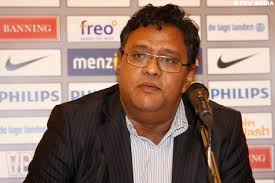By Mark Baber
November 27 – The All India Football Federation general secretary Kushal Das (pictured) has said that the Indian Super League will not be profitable for at least seven years but that it will be merge with the country’s I-League before 2020.
Das made the remarks at the Host Cities conference in Dubai as the new ISL league approaches 1 million supporters through the turnstiles with just 41 matches played.
Predicting that a single merged league would see 14-16 teams from across the country competing for eight months per year, Das abandoned the fiction that the ISL is not a league,
“The ISL and I-League are both products of the IFA [Indian Football Association],” Das said. “They are a means to an end – and the end is the development of Indian football. What the ISL is doing is creating an appetite for Indian football, which was missing for some time.
“A lot of people are coming to the grounds to see Indian football, so it will help the I-League as well.
“The infrastructure has been improved, the pitches have been refurbished and all that helps the I-League. So [the two leagues] can co-exist for some time now and then we’ll see at a later stage how to have one league.”
Das compared the match-day attendance of the ISL to date (about 25,000 on average) to that of the I-League which stands at around 12,000 to 13,000 saying that the new league was also attracting a different demographic;
“There’s a totally different profile,” he said. “If you go to any ISL game, you see a lot of young people and families, just like the IPL [The cricket equivalent of the ISL].
“They are two competing leagues, so there’s a fear there could be a problem, but many of the clubs have started to realise that it could actually be helpful to them and that’s why many [I-League teams] are loaning players to the ISL clubs.”
According to Das the only way for India to meet its new targets of breaking into the top 15 rankings in football in Asia by 2017 and into the top 100 in the world rankings by 2019 was to stimulate grass-roots interest in the sport. He pointed out that “ISL franchisees have to mandatorily start grass root scouting for players. They will also have to start football academies within the next three years. This will tremendously help find a new crop of footballers from across India.”
The much-hyped ISL has achieved attendances to date which make it the best attended league across Asia. It remains to be seen if the ambitious AIFF and IMG/Reliance strategy will be a long term success, if Indian fans will remain loyal to their domestic clubs, once the novelty factor has worn off, and whether India’s traditional I-League clubs will benefit or suffer in the face of the new “competing league.”
Contact the writer of this story at moc.l1738353084labto1738353084ofdlr1738353084owedi1738353084sni@r1738353084ebab.1738353084kram1738353084


